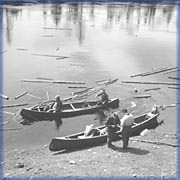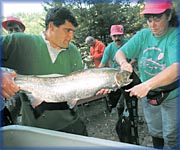|
The Move to Conserve
Dams ignite a conservation movement that
soon attacks pollution and overfishing.
 he ill effect of the
Mactaquac Dam on Atlantic salmon runs in the Saint John River
soon became apparent, but similar reductions in the number of
returning fish occurred on rivers without dams throughout the
1950s and 1960s. This phenomenon led a group of prominent
anglers in New Brunswick and Quebec to form the International
Atlantic Salmon Foundation. Besides river dams, it identified
overfishing because of increased access to rivers, commercial
netting, and industrial pollution as the main causes for
declining runs. he ill effect of the
Mactaquac Dam on Atlantic salmon runs in the Saint John River
soon became apparent, but similar reductions in the number of
returning fish occurred on rivers without dams throughout the
1950s and 1960s. This phenomenon led a group of prominent
anglers in New Brunswick and Quebec to form the International
Atlantic Salmon Foundation. Besides river dams, it identified
overfishing because of increased access to rivers, commercial
netting, and industrial pollution as the main causes for
declining runs.
|

|

Canoes and logs on the Miramichi river system, 1947
Lumbering and fish have had a rocky relationship, from the mill
wastes and stream jams to the clear cutting of the 1960s and
1970s, which fouled spawning grounds with silt.
(Provincial Archives of New Brunswick, P93-N378)
|
|
Eventually the foundation became the Atlantic Salmon Federation.
Based in St. Andrews, New Brunswick, the federation is a world
leader in salmon conservation, educating the public and lobbying
governments to restrict sport and commercial fishing and combat
pollution. Today, the Atlantic Salmon Federation and other river
management groups promote fish restocking programs, river
cleanups, and catch-and-release angling.
|

|
Stocking the Big Salmon River, 1995
Members of the Big Salmon River Angling Association place a
four-year-old salmon in a water-filled inner tube for transport
to the river. This group and others like it have worked to
restore salmon populations since the 1970s and 1980s.
Photo: David Nickerson
(Saint John Telegraph Journal)
|
|
|
|
|
|



